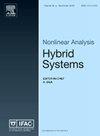条件有效随机系统的保形定量预测监测
IF 3.7
2区 计算机科学
Q2 AUTOMATION & CONTROL SYSTEMS
引用次数: 0
摘要
我们考虑预测监视(PM)的问题,即在运行时预测当前系统状态对期望属性的满足程度。由于PM方法与运行时安全保证和在线控制相关,因此PM方法需要高效地支持对预测的违规进行及时干预,同时提供正确性保证。我们介绍了定量预测监测(QPM),一种支持随机过程的PM方法和信号时间逻辑(STL)中给出的丰富规范。QPM通过预测其定量(即鲁棒性)STL语义(无论是空间的还是时间的),提供了对某些属性φ的满足的定量度量。QPM导出的预测区间计算效率很高,并且具有概率保证,因为该区间以任意概率覆盖相对于系统随机演化的STL鲁棒性值。为此,我们采用机器学习方法并利用分位数回归的保形推理的最新进展,从而避免在运行时进行昂贵的蒙特卡罗模拟来估计区间。我们还展示了如何以组合方式组合监视器来处理组合公式,而无需重新训练预测器或牺牲保证。我们进一步为QPM配备了技术,以确保预测区间的条件有效性,即,这样的概率保证相对于系统的任何状态(或任何满意度值)都保持不变,从而显著提高了结果监视器的一致性和可靠性。我们在包括随机多智能体系统在内的五个不同复杂程度的离散随机过程的基准上证明了QPM的有效性和可扩展性。本文章由计算机程序翻译,如有差异,请以英文原文为准。
Conformal quantitative predictive monitoring of stochastic systems with conditional validity
We consider the problem of predictive monitoring (PM), i.e., predicting at runtime the satisfaction of a desired property from the current system’s state. Due to its relevance for runtime safety assurance and online control, PM methods need to be efficient to enable timely interventions against predicted violations, while providing correctness guarantees. We introduce quantitative predictive monitoring (QPM), a PM method to support stochastic processes and rich specifications given in Signal Temporal Logic (STL). QPM provides a quantitative measure of satisfaction of some property by predicting its quantitative (a.k.a. robust) STL semantics, either spatial or temporal. QPM derives prediction intervals that are highly efficient to compute and with probabilistic guarantees, in that the intervals cover with arbitrary probability the STL robustness values relative to the stochastic evolution of the system. To do so, we take a machine-learning approach and leverage recent advances in conformal inference for quantile regression, thereby avoiding expensive Monte Carlo simulations at runtime to estimate the intervals. We also show how our monitors can be combined in a compositional manner to handle composite formulas, without retraining the predictors or sacrificing the guarantees. We further equip QPM with techniques to ensure conditional validity of the prediction intervals, i.e., such that the probabilistic guarantees hold relative to any state of the system (or any satisfaction value), thereby significantly enhancing the consistency and reliability of the resulting monitor. We demonstrate the effectiveness and scalability of QPM over a benchmark of five discrete-time stochastic processes with varying degrees of complexity, including a stochastic multi-agent system.
求助全文
通过发布文献求助,成功后即可免费获取论文全文。
去求助
来源期刊

Nonlinear Analysis-Hybrid Systems
AUTOMATION & CONTROL SYSTEMS-MATHEMATICS, APPLIED
CiteScore
8.30
自引率
9.50%
发文量
65
审稿时长
>12 weeks
期刊介绍:
Nonlinear Analysis: Hybrid Systems welcomes all important research and expository papers in any discipline. Papers that are principally concerned with the theory of hybrid systems should contain significant results indicating relevant applications. Papers that emphasize applications should consist of important real world models and illuminating techniques. Papers that interrelate various aspects of hybrid systems will be most welcome.
 求助内容:
求助内容: 应助结果提醒方式:
应助结果提醒方式:


